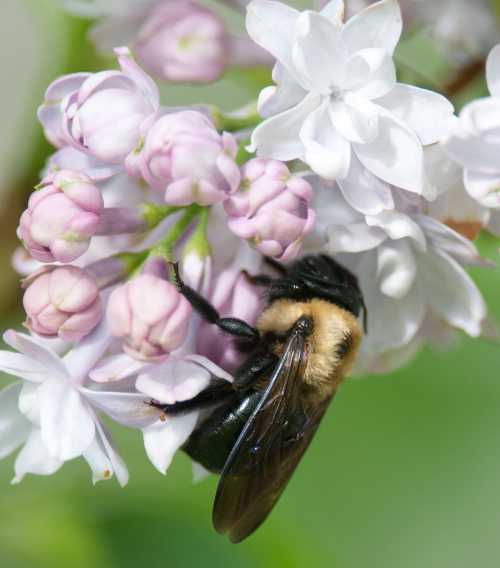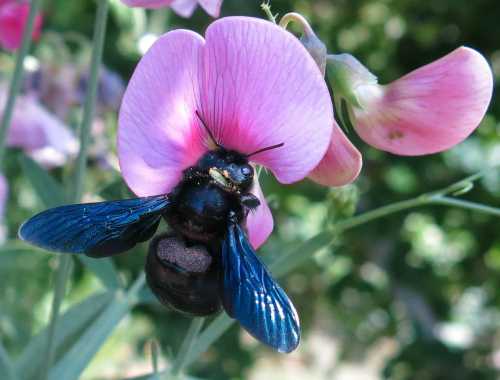Carpenter Bees: Getting rid, without harming them
Here are some ideas you can try if you'd like to get rid of carpenter bees without harming them.
Also,
prevention is better than cure, so take a look at my tips to help
prevent future carpenter bee nests.
But firstly, a little more information about carpenter bees.
Carpenter Bee Control And Prevention: Steps To Take
 Carpenter bees are sometimes mistaken for bumble bees. Above: Eastern Carpenter Bee - Xylocopa virginica
Carpenter bees are sometimes mistaken for bumble bees. Above: Eastern Carpenter Bee - Xylocopa virginica
Carpenter bees of the Xylocopa genus, usually usually build nests in dead or decaying wood1. Such wood is usually unpainted, and in structures with visible signs of age or rot.
They also like soft wood.
I received an email from a Mr Wayne Robey of Indiana. He wrote:
Just an observation:
I have a lot of carpenter bees here in Indiana and drilled some holes in their favorite 4 x 8 soft timber but most prefer to make their own entry holes about 3/8" in diameter and on the bottom of the wood, and many have chosen unpainted white pine under the eves of the house, some on nearly horizontal parts but more on wood at a 45 degree angle.
After painting these areas in the spring the old holes were still in use but there are no new ones.
Wayne Robery
The lesson seems to be that keeping vulnerable areas painted could be a good deterrent to carpenter bees.
1. Locate the nest
You may become aware of many carpenter bees around your property, but have no idea where the nest is.
- First, check old, unpainted, soft wood first, because this is the kind of wood carpenter bees prefer. Look for holes in the wood and observe to see whether any bees leave of enter them.
- If you cannot see a nest, next, check any crucial structures that are vital for a building, and that you need to be concerned about, such as supporting structures.
This includes inspecting house eaves and window frames. If there are no nests in any of these locations, you can begin to check more widely. (However, I recommend you PROTECT these structures from carpenter bees for the future, by keeping them painted - see below). - It's quite possible you'll find the nest in an old table leg, or some other item that is not important.
If so, you can simply move the table well away from your home, or dispose of it if this is an option, without harming the bees (carpenter bees are valuable pollinators).
2. Use an insect repellent and apply repeatedly
First, liberally apply a natural insect REPELLENT or one containing Picaridin, (rather than insecticide such as DEET).
Some people report that natural, home-made citrus sprays made from boiling citrus peels are helpful, and that citronella and almond oil are also effective.
Re-apply repeatedly, and observe the nest for a few days. Spray the repellent around the area – such as surrounding brick work, and keep repeating. The objective is to discourage the bees from coming back. DO ensure you are also protecting other areas, especially crucial structures.
You could also try using atmospheric repellents close to the nest site, such as citronella incense sticks.
If you have pets, ensure they cannot be harmed by the repellent you select.
3. Obstruct holes
If the bees remain determined to stay put, soak an old rag or cloth with insect repellent, and cover the nest entrance holes.
Observe the nest over the next few days. The bees will hopefully be repelled and will eventually stop returning.
If not, you may have to seal up the holes with caulk.
5. Replace old wood
If wood is rotting and needs to be replaced, it may be wise instead to leave the bees without going to the expense of treating the area.
Instead, cut out the wood section containing the nest in late autumn, when the nest is no longer active, but the next generation of bees are overwintering inside the tunnels.
You can then remove the nest to a location away from homes, and areas where there is risk of damage to crucial wooden structures.
 Violet carpenter bee
Violet carpenter beePrevention is better than cure! Deter carpenter bees
It's a good idea to take action sooner rather than later to deter carpenter bees:
- Keep wooden fixtures painted and well maintained - especially vulnerable areas.
- If you are especially worried, you could also apply an organic repellent around vulnerable areas during Spring. I
tend not to recommend pesticides, as I am concerned about using highly
toxic chemicals in the environment that may have wider environmental
impact and kill other bees unnecessarily. There are further issues regarding
future use and disposal, and the potential to harm beneficial insects, children, birds and pets.
Are carpenter bees dangerous?
It is important to put the situation in perspective – carpenter bees are rarely aggressive and stinging is unlikely to be a problem (only females can sting, but rarely do).
Males cannot sting, although they are territorial and may appear to follow you as they investigate your movements.
References
1. Tamar Keasar, "Large Carpenter Bees as Agricultural Pollinators", Psyche: A Journal of Entomology, vol. 2010, Article ID 927463, 7 pages, 2010. https://doi.org/10.1155/2010/927463
If you found this page helpful or interesting, I'd really be grateful if you would share it with others - if not this page, perhaps another, such as Gardening For Bees.
Thank you so much :) .